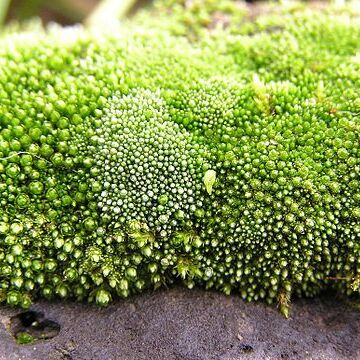Plants small to medium-sized, forming turfs or cushions, whitish or silvery green to green above, green below; terricolous or saxicolous. Stems julaceous, (1.0-)5.0-5.0 mm tall, branching below, yellowish green or red to red-brown, frequently radiculose below; rhizoids red-brown, coarsely papillose, tubers absent. Leaves crowded, occasionally distant below, imbricate wet or dry, concave; broadly ovate to oval or broadly oblong to obovate, 0.5-1.5 mm long; apex hyaline, apiculate to acuminate; margins plane, entire; border absent. Costa ending below apex to aristate, weak, frequently reddish below, awn to 0.8 mm long, hyaline, frequently denticulate; in section subround, ventral surface cells 2-3, dorsal stereid band present, stereids in 1-2 rows, dorsal surface cells incrassate, guide cells absent, hydroids few. Upper laminal cells hyaline, rnomboidal, occasionally flexuose, frequently thickened at the comers, (25-)37-75(-100) µm long, 10-17 µm wide, narrowly rectangular at margin; basal cells frequently reddish, quadrate to rectangular, extending up margin in 2-4 rows. Propagulae occasionally present in leaf axils. Dioicous. Perichaetia terminal; leaves oblong-acuminate to triangular, 1.0-1.5 mm long. Seta 7-12(-20) mm long, yellowish or red to reddish brown; capsule pendulous, ovoid or pyriform, 1-2 mm long, yellowish to reddisn yellow or dark red to reddish brown, contracted below mouth when dry, neck short, occasionally larger than urn, frequently abruptly narrowed towards seta, wrinkled when dry; exothecial cells irregularly rectangular, incrassate, shorter towards mouth, 2-4 rows at mouth transversely elongated; peristome double, exostome teeth yellowish to dark red or reddish brown, apex hyaline, narrowly oblong-acuminate, 0.2-0.4 mm long, finely papillose, endostome segments keeled, perforated, cilia 2-3, basal membrane high, minutely papillose, yellowish; operculum low-conic, blunt to apiculate; spores 10-15 µm, finely papillose.
More
Plants gregarious or in dense mats, white-green to silver-green. Stems 0.2-1 cm, strongly rounded julaceous or sometimes gemmiform. Leaves erect when moist, ovate to ovate-lanceolate, somewhat concave, 0.3-1(-1.2) mm; base green; margins rarely recurved proximally or plane distally; apex broadly rounded to acute, not cucullate, hyaline in distal 1/4-1/2 of leaf or rarely nearly entirely green; costa not reaching apex, apiculus present, sometimes short or nearly absent, hyaline, ; proximal laminal cells quadrate or short-rectangular, 12-18 µm wide, 1-2:1; distal cells short-or elongate-hexagonal, (30-)40-80 × 10-15 µm, (1-)3-5:1, walls thin or somewhat thickened, not distinctly incrassate. Specialized asexual reproduction by leaf axil bulbils, leafy, small. Seta brown to red-brown, 1-2 cm. Capsule red to red-brown, ovate, 2-3 mm; hypophysis differentiated, somewhat thickened. Spores 8-15 µm.
Plants small to medium-sized, forming turfs or cushions, whitish or silvery green. Stems julaceous, 1-25 mm long. Leaves crowded, imbricate, concave; broadly ovate to oblong, 0.5-1.5 mm long; apex hyaline, apiculate; margins entire; border absent; costa ending below to aristate, weak. Upper laminal cells hyaline, rhomboidal, basal cells frequently reddish, quadrate to rectangular, extending up margins. Capsule pendulous, ovoid or pyriform, neck short, wrinkled when dry.

